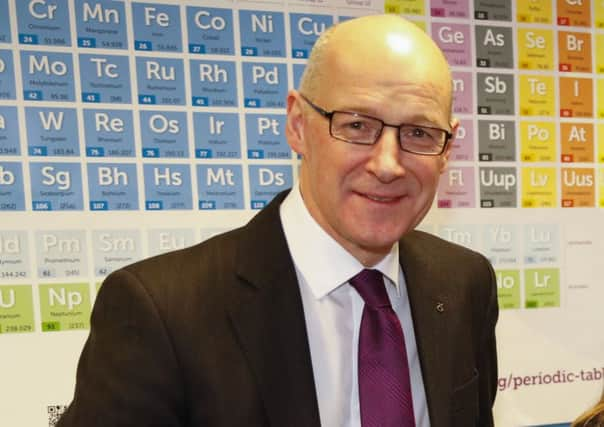Tom Peterkin: Sturgeon facing storm on domestic policy front


Remember Alex Salmond unveiling a taxpayer funded memorial to himself which bears his own Robert Burns inspired quotation celebrating his policy of free university education?
“The rocks will melt with the sun before I allow tuition fees to be imposed on Scottish students,” proclaims Salmond’s standing stone at Heriot-Watt University.
Advertisement
Hide AdAdvertisement
Hide AdWhen he was First Minister, Salmond was not shy in suggesting that the SNP’s approach to learning was an extension of a centuries-old commitment to free education, established by the Kirk following the Reformation.


This love of learning, nurtured by generations of Scots dominies, produced lads and lasses ‘o pairts’ whose intellect and belief in public service made Scotland a land of inventors, industrialists and philosophers.
When he was Education Secretary, Michael Russell used a speech at the opening of the Adam Smith Business School at Glasgow University to trace this golden thread of learning, which accounted for Scotland’s superior education system.
It was a thread rooted in John Knox’s 16th century drive to make education a national priority and led to the School Establishment Act of 1616, which saw schools built in every parish.
From there the thread ran through the Enlightenment of Adam Smith and David Hume to modern Scotland, where, according to Russell, its legacy could be found in Scottish Government policy.


“We can do all this because we have, as a foundation, the intellectual, political, social and economic benefits of Europe’s first universal public education system since classical antiquity,” said Russell, rather grandly.
Three and half years after Russell made that speech any attempt by the current Education Secretary John Swinney to describe Scotland as an educational exemplar would have a very hollow ring.
The “wha’s like us” attitude towards Scottish education has been dealt a devastating blow over the past couple of weeks with a series of statistics and reports painting a less than rosy picture of life in the classroom.
Advertisement
Hide AdAdvertisement
Hide AdThe first to dismantle the vestiges of Scotland’s reputation as a cradle of learning was last week’s Programme for International Student Assessment (Pisa) report.
The highly respected global study of the academic performance of 15-year-olds found that Scotland had slipped down the international rankings in reading, maths and science. Where Scotland had once recorded above average Pisa scores, the latest report found “average” performance levels in key subjects.
Other countries like Estonia and Slovenia (where, incidentally, the influence of John Knox and the Scottish Enlightenment had been minimal) outperformed the much vaunted Scottish education system.
Another week brought another damning verdict on the state of education in Scotland when the Scottish Government published a slew of statistics on Tuesday.
Analysis of the government’s own data on its flagship Curriculum for Excellence (CfE) policy suggested that “excellence” was perhaps not an apt description.
More than a quarter of 11-year-olds were not meeting CfE standards. Furthermore, the data highlighted the yawning gap between the poor academic performance of youngsters from impoverished backgrounds and the better results achieved by their richer counterparts.
Damningly for a government which has made closing the “attainment gap” a key priority, the gulf between poor and rich got bigger as children went through primary school. Problems with the education system may be embarrassing for a government and difficult for our dedicated teachers, but they can be devastating for children and their life chances.
It is not just education where the Nicola Sturgeon’s administration has found itself in choppy waters in recent days. Scotland has a proud and centuries old tradition of medical excellence. This week saw a slump in performance when it came to meeting Scottish government cancer waiting targets.
Advertisement
Hide AdAdvertisement
Hide AdCancer charities were concerned that proportion of patients who start treatment within two months of their urgent hospital referral has dropped to 87 per cent.
That compares unfavourably with the equivalent figures in 2010 when more than 97 per cent of patients received surgery or therapy within the 62 day target. Meanwhile ,the GP recruitment crisis shows no sign of abating. The domestic challenges also include economic ones. Yesterday saw the Office for National Statistics report that unemployment has increased by 14,000 in the period August to October 2016, and now stands at 145,000.
The Scottish unemployment rate now stands at 5.3 per cent, which is above the rate of 4.8 per cent for the whole of the UK.
These figures were produced at a time when economists were expressing concern that Scottish economic growth is behind that of the UK. With inflation on the rise there is food for thought for Finance Secretary Derek Mackay as he presents his draft budget to the Scottish Parliament today. Brexit may present its own challenges for the Scottish Government, but there is precious little room for conceit when it comes to its own domestic record.